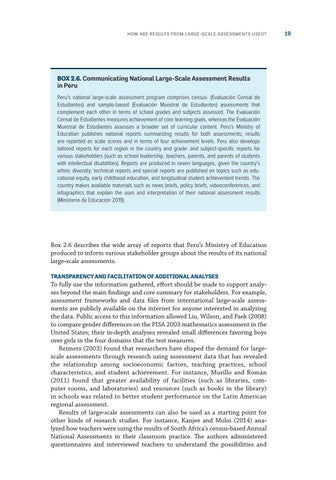How Are Results from Large-Scale Assessments Used?
BOX 2.6. Communicating National Large-Scale Assessment Results in Peru Peru’s national large-scale assessment program comprises census- (Evaluación Censal de Estudiantes) and sample-based (Evaluación Muestral de Estudiantes) assessments that complement each other in terms of school grades and subjects assessed. The Evaluación Censal de Estudiantes measures achievement of core learning goals, whereas the Evaluación Muestral de Estudiantes assesses a broader set of curricular content. Peru’s Ministry of Education publishes national reports summarizing results for both assessments; results are reported as scale scores and in terms of four achievement levels. Peru also develops tailored reports for each region in the country and grade- and subject-specific reports for various stakeholders (such as school leadership, teachers, parents, and parents of students with intellectual disabilities). Reports are produced in seven languages, given the country’s ethnic diversity; technical reports and special reports are published on topics such as educational equity, early childhood education, and longitudinal student achievement trends. The country makes available materials such as news briefs, policy briefs, videoconferences, and infographics that explain the uses and interpretation of their national assessment results (Ministerio de Educación 2019).
Box 2.6 describes the wide array of reports that Peru’s Ministry of Education produced to inform various stakeholder groups about the results of its national large-scale assessments. TRANSPARENCY AND FACILITATION OF ADDITIONAL ANALYSES
To fully use the information gathered, effort should be made to support analyses beyond the main findings and core summary for stakeholders. For example, assessment frameworks and data files from international large-scale assessments are publicly available on the internet for anyone interested in analyzing the data. Public access to this information allowed Liu, Wilson, and Paek (2008) to compare gender differences on the PISA 2003 mathematics assessment in the United States; their in-depth analyses revealed small differences favoring boys over girls in the four domains that the test measures. Reimers (2003) found that researchers have shaped the demand for largescale assessments through research using assessment data that has revealed the relationship among socioeconomic factors, teaching practices, school characteristics, and student achievement. For instance, Murillo and Román (2011) found that greater availability of facilities (such as libraries, computer rooms, and laboratories) and resources (such as books in the library) in schools was related to better student performance on the Latin American regional assessment. Results of large-scale assessments can also be used as a starting point for other kinds of research studies. For instance, Kanjee and Moloi (2014) analyzed how teachers were using the results of South Africa’s census-based Annual National Assessments in their classroom practice. The authors administered questionnaires and interviewed teachers to understand the possibilities and
19

